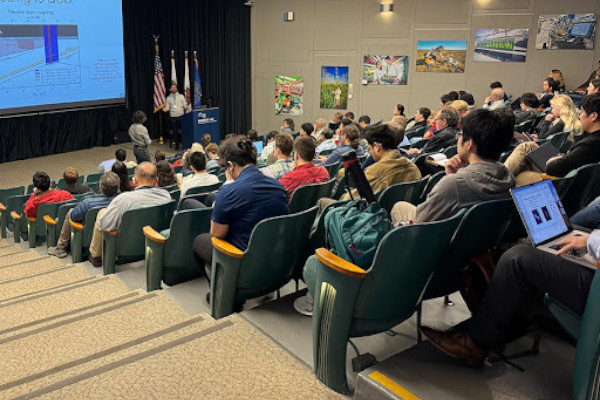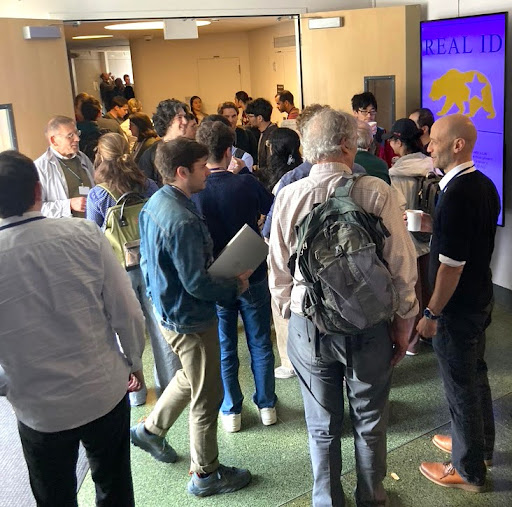Berkeley hosts Axion Dark Matter Workshop on May 7-9
Berkeley hosts Axion Dark Matter Workshop on May 7-9

(Credit: Tony Spadafora, Berkeley Lab)
May 16, 2025 — Marsha Fenner
Berkeley Lab Physics Division News
Berkeley Lab’s Physics Division and the UC Berkeley Physics Department hosted an Axion Dark Matter Workshop on May 7-9, 2025, to bring together experts focused on the discovery of axion dark matter.
More than 150 experimentalists and theorists from around the world gathered to explore the surge of recent advances in the field of axion dark matter research and to strategize how coordinated theoretical and experimental efforts can drive future axion discoveries. Axions are hypothetical elementary particles that could be the fundamental constituent of dark matter, the mysterious component that makes up the largest portion of the universe’s mass. With the recent development of instruments and experiments that are now equipped to probe the most probable parameters for axion discovery, in particular at sub-micro-electronvolt masses, researchers are getting closer to a deeper understanding of this theory of dark matter, which may have even broader implications for our understanding of string theory and other physics phenomena.
“The goal right now is to refocus the community on defining the next steps towards where we think axion dark matter could be and how to reach this experimentally. We're doing that by bringing together the absolute best panel of world experts to explore all of the aspects of this problem,” said event co-organizer Nick Rodd, a staff researcher in Berkeley Lab's Physics Division. “With dramatic advances in technology and quantum sensing, and with so many experts on how we can exploit these developments to look for axions, this will likely be remembered as one of the most important dark matter conferences this year.”
Natalie Roe, Associate Laboratory Director for the Physical Sciences, opened the workshop, and several high-profile keynote speakers honored the assembly. Hitoshi Murayama, a theoretical physicist in Berkeley Lab's Physics Division and a professor of physics at UC Berkeley who recently served as chair of the 2023 Particle Physics Project Prioritization Panel (P5) and now serves in the chair line of the executive committee of the American Physical Society's (APS) Division of Particles & Fields, presented a talk on the P5 and APS visions for upcoming short- and long-term dark matter and axions research. Edward Witten, a member of the Institute for Advanced Study and winner of the Fields Medal (1990), known for his contributions to string theory, topological quantum field theory, and other areas of mathematics, presented a talk on the connection between axions and string theory. Soren Prestemon, Deputy Director for Technology in the Accelerator Technology & Applied Physics (ATAP) Division and head of the US Magnet Development Program, presented a talk on the new magnet technologies that are being developed to search for axions. Manuel Bautista, a DOE Program Manager for High Energy Physics (HEP) and a professor emeritus of physics at Western Michigan University, outlined the DOE's vision for dark matter and axion searches.

(Credit: Liz Worthy, Berkeley Lab)
“This workshop brought together a wide range of axion enthusiasts, from world-leading experts to students just starting in the field, and the diversity of ideas presented was incredibly impressive,” said Chiara Salemi, a faculty scientist in Berkeley Lab's Physics Division and an assistant professor of physics at UC Berkeley who co-organized the event.
Rodd and Salemi organized the event with Kent Irwin (Stanford University), Ben Safdi (UC Berkeley), Karl Van Bibber (UC Berkeley), and Lindley Winslow (MIT). Funding was provided in part by the Department of Energy's Office of High Energy Physics.
“One takeaway from our few days together is that we are at the point where we are ready to start scaling up many of these ideas to definitive sensitivities,” continued Salemi. “Exploring the available parameter space for axions is a huge experimental challenge, but the field has now matured to the point wherehere are ideas for how we attack this from many directions, including a wide array of ongoing experiments and many more concepts for future detectors.”

(Credit: Tami Blackwell, Berkeley Lab)